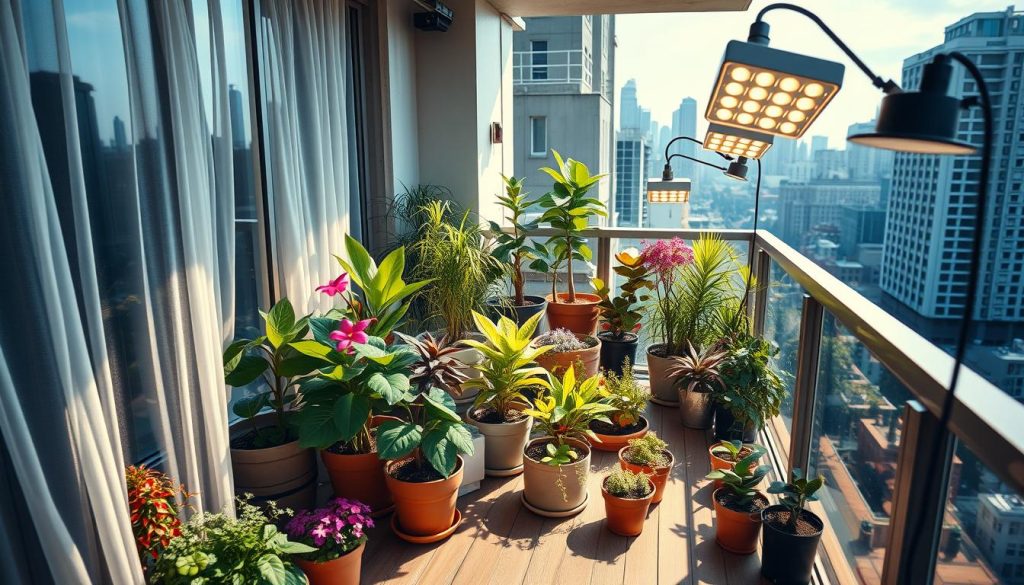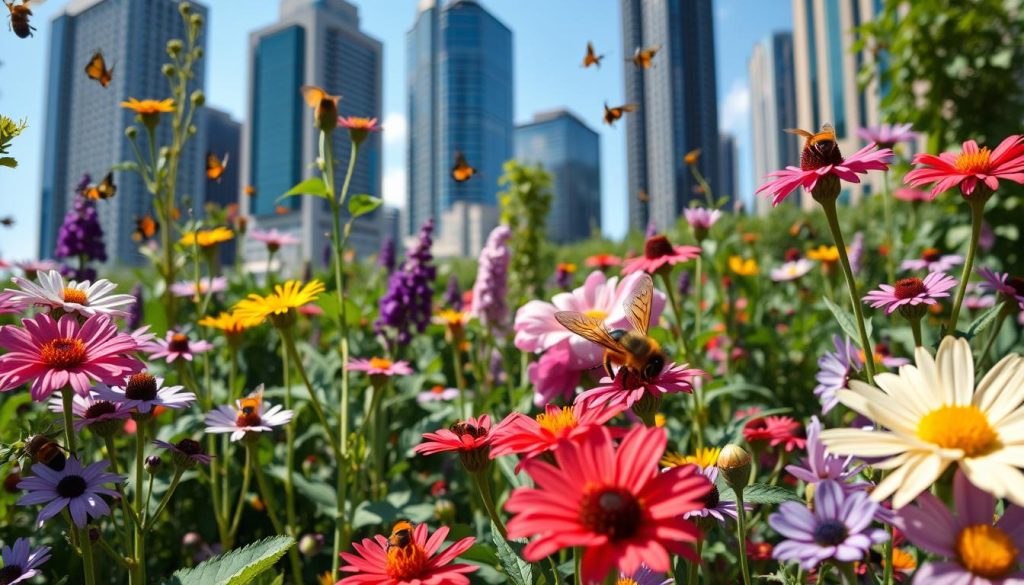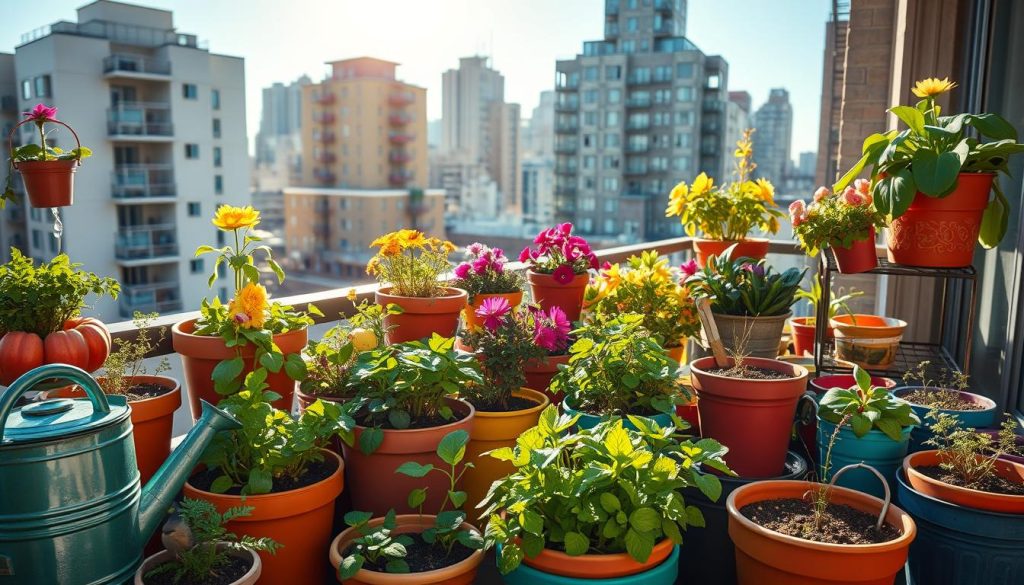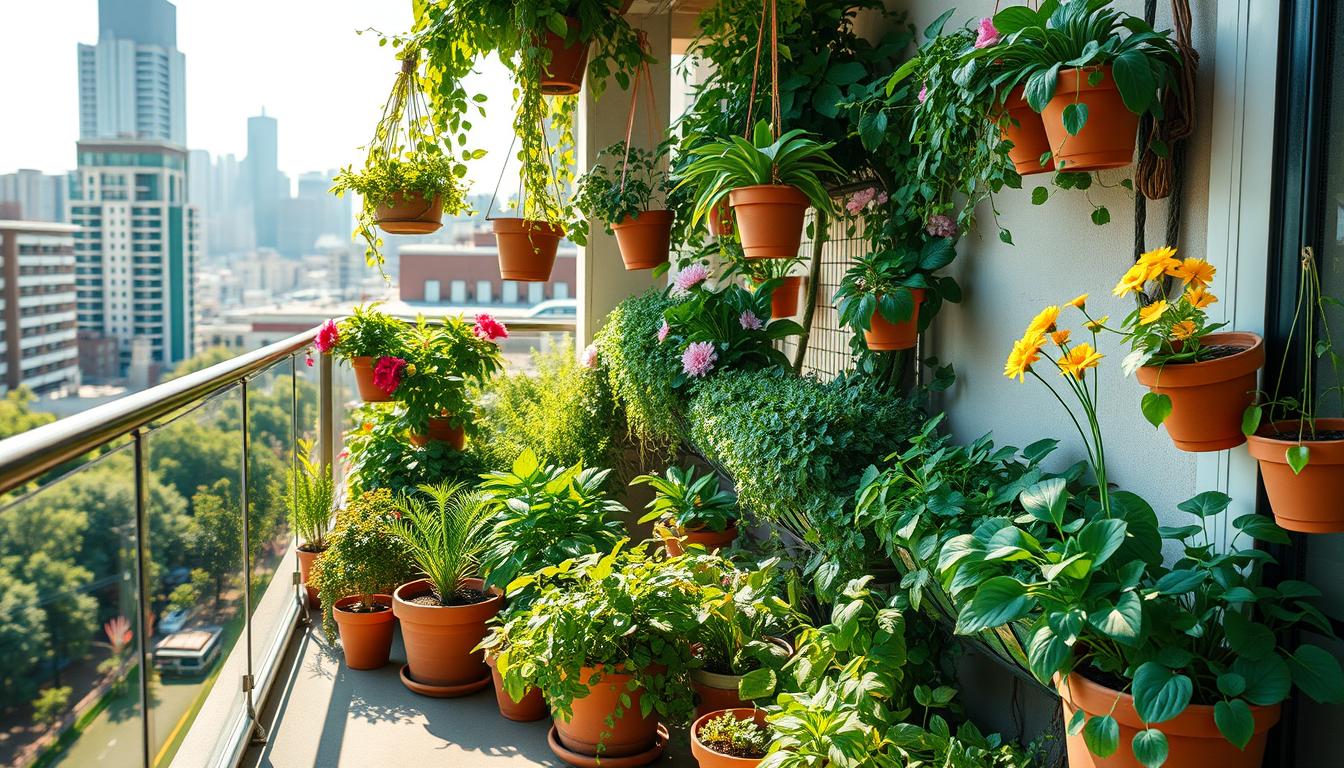Hey there, fellow city dwellers! I’m excited to share my passion for urban gardening with you. Living in a bustling metropolis doesn’t mean you can’t enjoy a slice of nature right at home. In this guide, I’ll share my favorite urban gardening tips to help you create a flourishing green space, no matter how small your area might be.
From picking the perfect plants for tight spaces to exploring creative container solutions, I’ve got you covered. Whether you’re a newbie or a seasoned gardener, get ready to transform your compact outdoor area into a lush oasis. Let’s dive into the world of small-space gardening and discover how to bring a touch of nature to your urban lifestyle!
Understanding the Benefits of Urban Gardening
Urban gardening tips are getting more popular. City folks want to connect with nature again. This hobby brings many benefits, not just growing plants.
Environmental Impact of Plants
My urban garden cuts down my carbon footprint. Plants in cities take in carbon dioxide and clean the air. They also cool the area. By growing my own food, I reduce emissions from transporting store-bought produce.
Mental Health Benefits
My urban garden has boosted my mental health. Caring for plants lowers stress and anxiety. Seeing my plants grow brings me joy.
Gardening gives me a sense of achievement. It connects me to nature, even in the city.
Community Engagement
Urban farming has brought me closer to my community. I’ve met neighbors and shared gardening tips and produce. Community gardens have popped up, creating friendships and a sense of unity.
These green spaces unite people. They make our neighborhoods stronger and more connected.
| Benefit | Impact on Individual | Impact on Community |
|---|---|---|
| Environmental | Reduced carbon footprint | Improved air quality |
| Mental Health | Decreased stress levels | Increased overall well-being |
| Social | New friendships formed | Stronger community bonds |
Choosing the Right Plants for My Space
Finding the right plants for my urban garden is crucial. It’s all about picking the perfect greenery for a thriving compact oasis.
Best Plants for Small Spaces
In my container gardening, I’ve discovered some top picks for small spaces. Herbs like basil and mint are fantastic. They grow well in small pots and add fresh flavors to my meals.
For a burst of color, I choose petunias and marigolds. They bloom all season and don’t need much room.
Seasonal Plant Selection
I plan my garden with the seasons in mind. In spring, I start with pansies and lettuce. Summer brings tomatoes and peppers.
Fall is perfect for chrysanthemums and kale. This way, my garden stays vibrant all year, even in a small space.
Edible vs. Decorative Options
I mix edible and decorative plants in my garden. Strawberries are both pretty and tasty. Nasturtiums add beauty with their bright flowers and are edible too.
For pure decoration, I choose colorful coleus or graceful ferns. They make my small space feel lush and green.
| Plant Type | Examples | Benefits |
|---|---|---|
| Edible | Herbs, Tomatoes, Strawberries | Fresh produce, Cost-saving |
| Decorative | Petunias, Ferns, Coleus | Beauty, Air purification |
| Dual-purpose | Nasturtiums, Lavender, Chives | Edible flowers, Attractive foliage |
By choosing a mix of these plants, I’ve created a thriving garden. It fits perfectly in my small urban space. It’s amazing how much joy and productivity I get from just a few well-chosen containers!
Essential Tools for Urban Gardening
Having the right tools makes urban gardening easy. Whether you garden indoors or outdoors, these essentials will help you succeed.
Must-Have Gardening Tools
My top tools include a hand trowel, pruning shears, and a watering can. They help me plant, trim, and care for my plants in small spaces. For indoor gardening, a spray bottle is key for misting leaves.
Budget-Friendly Alternatives
You don’t have to spend a lot to start gardening. Repurposed kitchen items are great. An old spoon can be a trowel, and yogurt containers are perfect for starting seeds. These tips save money and reduce waste.
Eco-Friendly Tools
I love sustainable gardening. Bamboo stakes are my go-to for supporting plants. I also use biodegradable pots from coconut coir or recycled paper. These tools are green and fit urban gardening well.
- Bamboo plant markers
- Compostable seed trays
- Natural fiber twine
The best tools are ones you’ll use. Start with the basics and add more as your garden grows. Happy planting!
Soil and Fertilization Basics
In urban farming and container gardening, good soil is key. Choosing the right soil and fertilizers is crucial for your garden’s success. Let’s explore the basics of soil and fertilization for thriving plants in city spaces.
Selecting Quality Soil
For container gardening, I choose a lightweight, well-draining potting mix. Heavy garden soil can harm roots. I prefer mixes with perlite or vermiculite for better drainage and aeration.

Organic vs. Synthetic Fertilizers
In my urban farming journey, I’ve tried both organic and synthetic fertilizers. Here’s a quick comparison:
| Organic Fertilizers | Synthetic Fertilizers |
|---|---|
| Slow-release nutrients | Fast-acting nutrients |
| Improve soil structure | Don’t improve soil long-term |
| Environmentally friendly | Can harm beneficial microbes |
| Less risk of over-fertilizing | Precise nutrient control |
Composting for Beginners
Composting has changed my container gardening. Starting with a small bin or tumbler is easy. I mix kitchen scraps with dry leaves. In a few months, I get rich, organic fertilizer for my plants. It’s a natural way to nourish my garden and reduce waste.
Innovative Container Gardening Ideas
I love finding new ways to grow plants in my city home. Container gardening lets me get creative and use every inch of space. Here are some cool ideas that have made my small garden a lush paradise.
DIY Container Options
Thinking differently can lead to unique planters. Old crates, vintage suitcases, and even old boots can become planters. My top DIY project is a vertical herb garden from a wooden pallet. It’s a blend of eco-friendly and stylish.
Vertical Gardening Solutions
Vertical gardening changed my small balcony. I use wall planters, hanging pockets, and tiered stands for a green wall. It saves space and makes my garden more interesting. Succulents, vines, and small herbs do well here.
Hanging Planter Ideas
Hanging planters add depth to my garden. I’ve tried macramé and metal planters for different looks. My latest project is a “living chandelier” with hanging plants. It’s a beautiful centerpiece for my outdoor dining.
| Container Type | Best Plants | Space-Saving Level |
|---|---|---|
| Wooden Pallet | Herbs, Succulents | High |
| Hanging Baskets | Petunias, Ferns | Very High |
| Tiered Stand | Mixed Vegetables | Medium |
| Wall-Mounted Planters | Air Plants, Cacti | Very High |
Maximizing Light for My Plants
Light is key for growing plants in the city. I’ve learned to manage light well for my plants. Here are some tips to use light better in urban gardening.
Understanding Sunlight Needs
Each plant needs different amounts of light. I check my space’s light and pick the right plants. For window farming, I choose plants based on the light each window gets.

Using Reflective Surfaces
To get more light, I use mirrors and white walls. These surfaces bounce light to dark spots. It’s great for my window garden, making sure plants get enough light.
Supplemental Lighting Solutions
When natural light isn’t enough, I use grow lights. LED lights are good because they save energy and help plants grow. I use them for my herbs and greens, so they always get enough light.
Maximizing light has helped me grow many plants in my city space. These tips have made my indoor garden thrive, even in tough light conditions.
Watering Techniques for Success
Learning how to water plants is crucial for urban gardening. Proper hydration is essential for your balcony garden’s success. Here are some tips for watering your plants effectively.
How to Water Effectively
Timing is everything when watering. I water my plants in the morning or evening to cut down on evaporation. For balcony gardening, I use a watering can with a narrow spout. This directs water to the soil, not the leaves, preventing fungal diseases and ensuring roots get enough moisture.
Drip Irrigation Systems
Drip irrigation has transformed my urban gardening. It delivers water directly to the roots, reducing waste and keeping leaves dry. I’ve created a DIY drip system using perforated hoses and a timer. It saves me time and boosts plant health.
Signs of Overwatering vs. Underwatering
It’s important to recognize when plants are stressed from too much or too little water. Overwatered plants turn yellow and have soggy soil. Underwatered plants wilt and have dry, crispy leaves. I check my plants daily and adjust my watering schedule based on these signs and the weather.
| Watering Issue | Signs | Solution |
|---|---|---|
| Overwatering | Yellowing leaves, soggy soil, mold growth | Reduce watering frequency, improve drainage |
| Underwatering | Wilting, dry soil, crispy leaf edges | Increase watering frequency, use mulch to retain moisture |
Coping with Urban Wildlife
Urban farming and small-space gardening bring nature closer to home. But, they also attract wildlife. I’ve learned to balance my garden’s needs with the local ecosystem. Let’s explore how to manage common pests, attract helpful insects, and find humane solutions for wildlife conflicts.
Common Pests and How to Manage Them
In my urban farming journey, I’ve faced many pests. Aphids, slugs, and squirrels often visit. I use natural repellents like neem oil for insects and physical barriers for larger animals.
Companion planting has been a game-changer. It deters pests without harsh chemicals.
Attracting Beneficial Insects
Beneficial insects are a gardener’s best friends. I’ve planted flowers like marigolds and lavender to attract ladybugs and bees. These helpers naturally control pests and pollinate my crops.
Creating a diverse plant habitat in my urban garden has improved its health and productivity.

Humane Solutions for Wildlife Conflicts
When dealing with larger urban wildlife, I opt for humane solutions. I use motion-activated sprinklers to deter deer and raccoons. For birds, I’ve found that reflective tape works wonders.
These methods protect my small-space garden without harming the animals that share our urban environment.
| Urban Wildlife | Humane Solution | Effectiveness |
|---|---|---|
| Squirrels | Squirrel-proof bird feeders | High |
| Rabbits | Fencing with buried edges | Medium |
| Deer | Motion-activated sprinklers | High |
| Birds | Reflective tape | Medium |
Supporting Plant Growth with Mulching
Mulching is a game-changer in urban gardening. It’s key for my container gardening success. Here are some tips on how mulching can transform your garden.
Benefits of Mulching
Mulching has many benefits for city gardens. It saves water, keeps weeds away, and controls soil temperature. In my containers, mulch keeps the soil moist longer, cutting down on watering. It also makes my garden look polished and professional.
Types of Mulch for Urban Settings
I’ve tried different mulches in my container gardening. Here are some great options for city gardens:
- Wood chips
- Straw
- Compost
- Pebbles
- Coconut coir
How to Apply Mulch Properly
Getting mulch right is crucial. I water the soil first. Then, I spread a 2-3 inch layer of mulch around my plants, leaving space near the stems. For containers, I use a thinner layer to avoid overwhelming the pot.
| Mulch Type | Depth | Best For |
|---|---|---|
| Wood chips | 2-3 inches | Large containers |
| Straw | 1-2 inches | Vegetable gardens |
| Pebbles | 1 inch | Succulents |
By using these urban gardening tips and mulching techniques, you’ll see a big difference in your plants’ health and look. Happy gardening!
Seasonal Gardening Tips for Urban Areas
Urban gardening tips change with the seasons. I’ve learned to adapt my approach throughout the year. Let’s explore how to keep your urban garden thriving no matter the weather.
Spring Planting Essentials
In spring, I prepare my urban garden for growth. I clean up winter debris and test soil pH. Then, I plant cool-season crops like lettuce and peas.

Summer Care Techniques
Summer brings its own challenges. I water deeply in the early morning to combat heat stress. Mulching helps retain moisture and suppress weeds.
For my indoor garden, I ensure proper ventilation. I adjust watering schedules to prevent overheating.
Fall Preparation Strategies
As fall approaches, I plan for cooler weather. I plant cold-hardy vegetables like kale and Brussels sprouts. I also bring sensitive plants indoors to extend the growing season.
Composting fallen leaves provides rich nutrients for next year’s garden.
By following these urban gardening tips and embracing indoor gardening techniques, I maintain a productive garden year-round. Each season offers unique opportunities to grow and learn in my urban oasis.
Creating a Beautiful Urban Garden Design
Designing a beautiful urban garden is an exciting challenge. I love transforming small spaces into green havens. Let’s explore how to create a stunning garden design that maximizes every inch of your urban oasis.
Planning My Garden Layout
I start by measuring my space and sketching a rough layout. For small-space gardening, I focus on multi-functional areas. A cozy seating nook can double as a herb garden.
Vertical gardening is my go-to for maximizing space. I use wall-mounted planters and trellises to grow upwards, not outwards.
Color Schemes and Aesthetics
I choose a color palette that complements my outdoor furniture and home exterior. Cool blues and purples create a calm atmosphere. Vibrant reds and yellows add energy.
I mix textures too, combining smooth-leaved plants with feathery ferns for visual interest.
Incorporating Privacy with Plants
Privacy is key in urban settings. I use tall, slender plants like bamboo or ornamental grasses as natural screens. For balconies, I hang trailing plants from railings.
Vertical gardening techniques work wonders here – a living wall of ferns or succulents can create a secluded retreat.
| Plant Type | Privacy Level | Maintenance | Best for |
|---|---|---|---|
| Bamboo | High | Low | Tall screens |
| Climbing Roses | Medium | High | Trellises |
| Hanging Ferns | Low | Medium | Balcony railings |
| Succulents | Low | Low | Living walls |
Connecting with Fellow Urban Gardeners
As an urban farmer, I’ve learned that connecting with other gardeners is crucial. Joining forces with fellow plant lovers in balcony gardening has been transformative. Here are some ways I’ve grown my green circle and honed my urban farming skills.
Online Communities and Resources
I’ve found a treasure trove of knowledge in online forums for urban farming. Sites like Reddit’s r/UrbanGardening and Facebook groups for balcony gardening are full of tips. These spaces allow me to ask questions, share my successes, and learn from others.
Local Gardening Clubs
In my city, I joined a local urban gardening club. We meet monthly to swap seeds, tools, and discuss our projects. It’s incredible how much you can learn from neighbors who face similar challenges. Check your local community center or library for club listings.
Events and Workshops to Attend
I always try to attend urban farming workshops and events in my area. From seed starting classes to composting seminars, these sessions have improved my skills. Local nurseries often host these events, and I’ve met wonderful gardening friends there. Don’t miss out on the chance to expand your knowledge and network!

